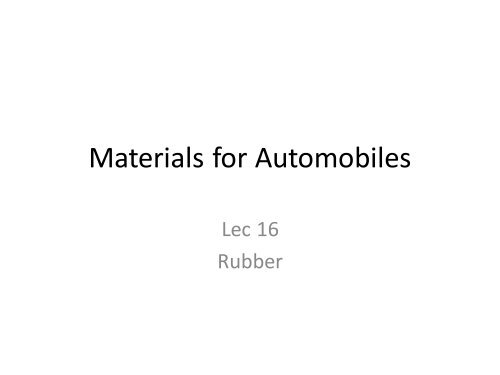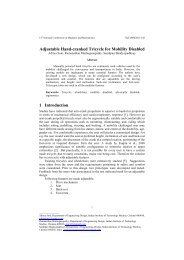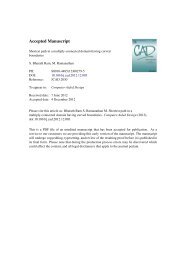Lecture 16
Lecture 16
Lecture 16
You also want an ePaper? Increase the reach of your titles
YUMPU automatically turns print PDFs into web optimized ePapers that Google loves.
Rubber – Effect of Vulcanizing
Rubber Basics : NRHHCHGutta percha or Balatta(trans-polyisoprene)HHCHHHCCC HCCHHHHC CC HH HHevea Rubber(cis-polyisoprenene)H
Rubber Polymer Type : Natural Rubber2.3.1 Natural rubber , NR• Extracted from rubber trees with present suppliers being Malaysia, Indonesia, SriLanka, Nigeria and others.• Polymer is polyisoprene,• Vulcanized products made have high mechanical strength and very good dynamicmechanical properties• Can be compounded to have excellent elasticity (ability to snap back to theiroriginal shape).• NR has very good abrasion resistance ,• low relative cost,
Rubber Polymer Type : Natural RubberApplications of NR :• slurry pump liners and impellers as well as for tank linings.• Tires, rubber springs and vibration mounts.• excellent for fine particle impact applications. NR rubber has a very highelasticity, thus most of the kinetic energy of an impacting particle isconverted into deformation which then releases the energy by returningto its original undeformed state.• It also has very good low temperature resistance, down into the region of-57 ˚C at which its stiffness shows a considerable increase.• Its high temperature heat aging resistance limit for 'continuous' use is inthe region of 75 ˚C . Significant components of weather resistance, are UVlight and ozone. Addition of carbon black to a compound gives resistanceto UV. Antiozonants and waxes, and helps with ozone resistance. Ozoneattack is of most concern for thin products and those that are subjected tostretching in service.• Electrical insulation is very good and is dependant on compounding.• Resistance to petroleum oils is poor while resistance to alcohols (such asethanol and methanol) and ketones (such as methyl ethyl ketone (MEK)and acetone) is much better.• Synthetic polyisoprene (IR) has basically similar properties to those of NRand has a more consistent rate of curing and processing characteristics, ata presently slightly higher relative price.
Rubber Polymer type : Nitrile Rubber2.3.4 Nitrile NBRAcrylonitrile butadiene rubber, to others it is also called Buna-N or nitrile rubber.• It is the workhorse of the marketplace for its oil resistant properties.• The grades offered differ in the percentage of acrylonitrile (ACN) in the polymer chainas well as the overall viscosity of the polymer.• NBR also has superior fuel resistance. The terms oil and fuel used here refers looselyto those products derived from petroleum.• The weather resistance of NBR is poor, similar to NR and SBR, although it can beenhanced by blending with the plastic, polyvinyl chloride (PVC), at some 'cost'to itslow temperature properties.• The alcohol causes NBR in contact with the gasoline alcohol blend to swellsignificantly. Blends above 5% should be treated with caution unless a resistantrubber type is used. However it has excellent resistance to non polar petroleum oils.• This also means that NBR has poor resistance to polar liquids such as ketones, esters,chlorinated solvents, and highly aromatic solvents such as benzene and toluene.
Rubber Polymer type : Chloroprene Rubber2.3.3 Polychloroprene CRThe CR ( chloroprene rubber), more popularly known as Neoprene.• it has a measure of both oil and weather resistance.• The oil resistance would only be considered moderate.• CR has similar dynamic mechanical characteristics to NR, including goodmechanical strength .• CR has some ability to retard flame, which means that when a source of flameis removed, the burning polymer will have a tendency to self extinguish, (thiscan be modified to improve or unintentionally diminish this property), whileNR, EPDM, and SBR for example, will continue to burn.• Upper continuous heat aging resistance temperature limits are of the order of90 ˚C. SAE defines continuous upper temperature resistance as, thetemperature at which the material retains a minimum of 50% of both originalelongation and tensile strength at break after 1008 hours (6 weeks).• Recommended upper range for CR in air is 99 ˚C for 1,000 cumulative hours and85 ˚C for 10,000 cumulative hours. Other sources put it at 91 ˚C for 1,000cumulative hours and 85 ˚C for 10,000 cumulative hours.• CR shows some stiffening at around -18 ˚C , becoming brittle around -40 deg C,although this can be lowered using certain compounding ingredients.• Resistance of CR to dilute acids and bases is better than that of NR or SBR,• Cost is somewhat higher than NR/ SBR
Rubber Polymer type : EPDM Rubber2.3.5 Ethylene propylene rubber EPM and EPDMEPM is a copolymer consisting of ethylene and propylene units as part of the mainpolymer chain• EPDM is largely unaffected by weather with very good resistance to ozone.• Dupont literature quotes EPDM products which were exposed to 10,000 partsper hundred million of ozone for 1,000 hours in air, at room temperature,without cracking.• Raw gum elastomer manufacturers' literature [ 12, 13, 14, 151 indicate upper'continuous'heat aging temperature limits in air five cumulative years at 100 degC.• Low temperature flexibility is very good and compares well with NR, and• like NR and SBR, EPDM (with a lower polarity than NR) has very poor oilresistance.• The price conscious rubber compounder is aware of the low specific gravity ofthe raw gum• The use of EPDM is dominant in roof membrane linings and extruded channelsfor windows because of the above properties.• EPDM has also been used as a blend with NR in tire sidewalls to improveresistance to cracking by ozone attack.• The excellent electrical resistance of EPDM promotes its use in medium andhigh voltage cable covers.
• IIR has some properties similar to those of EPDM, such as good mineral acid and baseresistance (like EPDM some concentrated mineral acids are a problem), and weatherresistance which is similar to that of EPDM.• IIR has excellent resistance to permeability by gases. For example, Fusco [18]mentions its permeability to air being as low as 10% that of NR, at 65 deg C.• Like EPDM, the polarity of IIR is low which means poor resistance to petroleum oilsand conversely low swell in many polar solvents, such as ketones.• Resilience is poor, which translates to good damping ability.• The upper continuous heat aging temperature limit is around 121 deg C, which can bedistinctly improved with IIR compounds containing resin (polymethylol-phenol) curesystems.• For low temperature properties the vulcanizate becomes stiff and leathery at around -18 deg C, although it is not brittle until around -70 deg C.• Applications naturally following from these properties include mounts and bumpersfor vibration and shock prevention, roof and tank linings, curing bladders and innertubes for tires.• A significant use is inner liners for tubeless tires, where halobutyl is preferred due toimproved interply adhesion with the rest of the inner tire.Rubber Polymer type : Butyl Rubber2.3.6 Butyl rubber IIR and halobutyl rubber CllR and BllRButyl rubber is a copolymer of isobutylene and isoprene, hence IIR. If a halogen, such aschlorine or bromine, is introduced into the polymer architecture, it becomes CIIR or BIIR,respectively.
Rubber Basics : FluoroelastomersHHFFCCCCHFVinylidene fluoride monomerFFTetrafluoroethylene monomer
Rubber Basics : Fluoroelastomers• Many of the desirable properties of flouropolymers– Low solvent effects• Excellent for chemical and petroleum handling applications– High thermal stability• Good for gaskets and seals
Rubber Polymer type : Fluorocarbon Rubber2.3.9 Fluorocarbon rubber FKM (FPM)In the United States fluorocarbon rubber is well known by its trade name of VitonBased on vinylidene fluoride and hexafluoro-propylene• Like silicone rubber, FKM has excellent high temperature resistance with an uppercontinuous heat aging temperature limit of 205 deg C.• FKM is usually serviceable at temperatures down to -20 deg C in dynamic applications,while for static use the temperature can be lower.• A primary variable in FKM grades is the level of fluorine in the elastomer molecule,FKMs being fluorohydrocarbons . Terpolymers tend to have a higher fluorine contentthan copolymers excellent resistance to oxidation, ozone, fuels and petroleum oils andare resistant to most mineral acids at high concentrations.• Although FKM has good resistance to many chemicals, excessive swelling occurs insome polar solvents such as low molecular weight ethers, esters and ketones.• Chemicals such as alkalis and amines should be used with caution, with standardfluorocarbon grades,.• FKM has a tendency to self extinguish when a flame is removed• Applications for FKM include automotive fuel hose liners and seals and flue ductexpansion joints, where high temperatures and acidic exhaust is present.• The relative cost of FKM is high, more than any of the elastomers mentioned so far,also a high specific gravity (around 1.8) means less cured product (volume) per unitweight
Rubber Basics : SiliconesHHCHH( S O ) n (H C HH) nH
Rubber Polymer type : Silicone Rubber2.3.7 Silicone rubber Q• Most elastomers have a carbon main chain, while Q has a silicone oxygenbackbone.• Silicone has an upper continuous heat aging temperature in the region of205 deg C.• Estimated service life for Q as follows: 40 years at 90 deg C, 2-5 years at 200deg C and two weeks at 315 deg C. Moisture, such as might be found in apoorly ventilated environment, can be a problem at high temperature [21].• Silicone is among the best elastomers for both high and low temperatureresistance.• Silicone rubber has excellent ozone, weather resistance and electricalinsulation.• Like CR, Q has a measure of flame retardant ability.• Mechanical properties such as tensile strength, are low, but change very littlewhen measured at higher temperatures; at 150 deg C, it is catching up withother elastomers• Oil resistance is about the same as that of CR;• acid and alkali resistance are not good.• Applications include aerospace, medical, food contact, and automotiveignition cable.• The cost of the raw gum elastomer is higher than any of the rubbers.
Rubber Polymer type : Trade Names
Rubber Polymer type : Trade Names
SAE J200 Rubber Classification
SAE J200 Rubber Classification
SAE J200 Rubber Classification
SAE J200 Rubber Classification
SAE J200 Rubber Classification
Typical Rubber Compound Ingredients
Rubber Compound Mixing• Compounding– Banbury mixer
Rubber Compounding Ingredients : Cross linking Agents3.3.2 SulfurIt is interesting to note that sulfur is still by far the most used cross-linking agent in therubber industry since its use by Goodyear and Hancock.It reacts chemically with the raw gum elastomer forming cross-links between the polymerchains, resulting in a more dimensionally stable and less heat-sensitive product.Its cost is relatively low but its function is essential.It is available in different particle sizes (fineness) as rubbermakers sulfur, and can alsohave a small quantity of oil added to reduce its dust in the air during handling.Rubbermakers sulfur is sulfur suitable for vulcanizing rubber; it has a low ash content,low acidity and sufficient fineness for adequate dispersion and reaction.3.3.3 Zinc oxide and stearic acidThese two materials, together with sulfur and accelerator, constitute the ‘cure system’for the formulation. Zinc oxide reacts with stearic acid to form zinc stearate (in somecases zinc stearate is used in place of zinc oxide and stearic acid) and together with theaccelerator they speed up the rate at which sulfur vulcanization occurs. With sulfuralone, the curing process might take hours. With this curing system, it can be reducedto minutes.
Rubber Compounding Ingredients : Cross linking Agents3.3.5 Other cross-linking systemsPeroxidesPeroxides are suitable for curing rubber but are not recommended for someelastomers such as IIR or CIIR.Peroxides can be used to cure many elastomers, since, unlike sulfur, they do not needunsaturated bonds (see section 6.1) in the polymer. Thus they may be used to cureether-type polyurethanes, certain fluoroelastomers ,silicones and all of the previouslymentioned saturated elastomers. Peroxides can also be used to cross-link CR.Although not nearly as popular as sulfur, peroxides have a distinct place in rubbercompounding, and are a major curative for silicone rubber.In the basic rubber compound formulation, the zinc oxide, stearic acid, sulfur andaccelerator can all be replaced by a single material, the peroxide.Peroxides as curing agents can confer some advantages.:• First an improvement in the heat aging resistance of the vulcanizate, thus uppertemperature limits can be pushed up a little or the lifetime extended.• Compression set (see section 5.4.5) is also improved. On the other hand, tensilestrength, tear strength, and fatigue (dynamic deformation such as constant flexing)life are reduced. A post cure (continued cure outside of the mold) is sometimesundertaken with peroxide cured vulcanizates, to complete the cure and removeunwanted byproducts.• The cross-link density of a peroxide cured compound can be increased by additionof chemicals called coagents, of which methacrylates are a good example. Thisresults in a higher state of cure with improvements in properties such as
Rubber Compounding Ingredients : Accelerators3.3.4 AcceleratorsThe accelerator (not to be confused with a catalyst, which remains fully availableat the end of a chemical reaction), is usually understood to mean an organicchemical, and as the name implies, it speeds up the rate of vulcanization.There are many accelerators available to the rubber chemist, grouped into severalchemical classes.Some have a built in delay time, so that when heat is applied to the compound atthe beginning of the curing process, no vulcanization (cross-linking) takes place fora specified initial period of time. They are appropriately called delayed actionaccelerators, An example would be the sulfenamides. This delay is highlybeneficial if a compound takes a long time to completely fill a cavity in a heatedmold.The following is a summary of some typical chemical classes of acceleratorsavailable to the rubber chemist.• Zinc dibutyl dithiocarbamate (ZDBC).• Thiurams Example: Tetramethylthiuram disulfide (TMTD).• Thiazoles• Guanidines• Sulfenamides
Rubber Compounding Ingredients : Antioxidants3.3.6 Antioxidants, age resistors and antidegradantsantioxidants are also necessary to protect other organic materials,such as most elastomers’ from aging.Aging can be caused by the ravages of oxygen, accelerated by heat.Antioxidants are designed to slow down this process and can act asfree radical scavengers.Antiozonants, such as the p-phenylene diamines, which providesacrificial protection against ozone, are also important, and are oftenadded to a compound.Classification of antidegradants is found in ASTM D 4676 [12].An antidegradant is a compounding material used to retard thedeterioration caused by oxidation, ozone, light or combinations ofthese
Rubber Compounding Ingredients : Fillers3.3.7 Fillers• While the cured raw gum elastomers of NR and CR are mechanically strong,most gums are weak when vulcanized and they need reinforcing fillers.• Reinforcement effect increases mechanical strength (for example tensilestrength and resistance to tearing) and stiffness.• Addition of filler increases hardness of the cured product. All fillers are notcreated equal, so that there is a range of reinforcement from very high tovery low, corresponding to the primary size of the filler particle, fromaround 10 nm for very fine particle carbon blacks giving high reinforcement,to greater than 300 nm for some calcium carbonates which give lowreinforcement. Use of the latter reduces compound cost.The shape and surface chemistry of the filler particle also play an importantpart in reinforcement. Some popular fillers are, in order of decreasingreinforcement :• carbon blacks and silicas,• clays and then• whitings (calcium carbonate, otherwise known as chalk).
Rubber Product : Tires• Tire production can be summarized in three steps:1. Preforming of components2. Building the carcass and adding rubber strips to form the sidewalls andtreads3. Molding and curing the components into one integral piece• The following descriptions of these steps are typical; there are variations inprocessing depending on construction, tire size, and type of vehicle on which thetire will be used• The carcass consists of a number of components, most of which are rubber orreinforced rubber• These, as well as the sidewall and tread rubber, are produced by continuousprocesses and then pre-cut to size and shape for subsequent assembly• The components include: bead coil, plies, inner lining, belts, tread, and sidewall©2002 John Wiley & Sons, Inc. M. P.Groover, “Fundamentals of ModernManufacturing 2/e”
Rubber Product : TiresBuilding the Carcass• The carcass is traditionally assembled using amachine known as a building drum, whosemain element is a cylindrical arbor that rotatesFigure 14.6 - Tire just before removal from building drum, but prior tomolding and curing
Rubber Product : TiresMolding and Curing• Tire molds are usually split molds and containthe tread pattern to be impressed on the tireFigure 14.7 - Tire molding: (1) uncured tire is placed over expandablediaphragm; (2) mold is closed and diaphragm is expanded toforce uncured rubber against mold cavity, impressing treadpattern into rubber; mold & diaphragm are heated to cure rubber©2002 John Wiley & Sons, Inc. M. P.Groover, “Fundamentals of ModernManufacturing 2/e”
Rubber Belts for Conveyors and Pulleys• Widely used in conveyors and mechanical power transmission systems• As in tires, rubber is an ideal material for these products but the belt must havelittle or no extensibility in order to function– Accordingly, it is reinforced with fibers, commonly polyester or nylon• Fabrics of these polymers are usually coated by calendering, assembled togetherto obtain required number of plies and thickness, and subsequently vulcanized bycontinuous or batch heating processes
Other Rubber Products – Hose• Two basic types:1. Plain hose (no reinforcement) is extruded tubing2. Reinforced tube consists of:• Inner tube - extruded of a rubber compounded for particular liquidthat will flow through it• Reinforcement layer - applied to the inner tube as a fabric, or byspiraling, knitting, braiding• Outer layer – compounded for environmental conditions andapplied by extrusion©2002 John Wiley & Sons, Inc. M. P.Groover, “Fundamentals of ModernManufacturing 2/e”
Rubber Product : Compression Moulding• Rubber parts produced by compression molding (the traditional process) can oftenbe produced in quantities of 1000 or less– The mold cost is relatively low compared to other molding methods• Injection molding, as with plastic parts, requires higher production quantities tojustify the more expensive mold• Draft is usually unnecessary for molded parts of rubber, because its flexibilityallows it to deform for removal from the mold• Shallow undercuts, although undesirable, are possible with rubber molded partsfor the same reason• The low stiffness and high elasticity of the material permits removal from the mold




